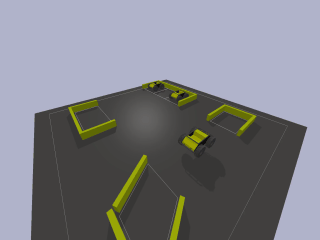基于DQN算法实现模拟小车倒车入库,强化学习算法使用stable-baselines3实现,小车和倒车环境基于pybullet实现。
- 强化学习算法、小车代码:https://github.com/RyanLiu112/RL_parking
- echarts代码:https://github.com/RyanLiu112/RL_parking/tree/main/echarts%E4%BB%A3%E7%A0%81
- PDF版论文:https://github.com/RyanLiu112/RL_parking/blob/main/%E8%87%AA%E5%8A%A8%E9%A9%BE%E9%A9%B6%E4%B8%AD%E7%9A%84%E6%B7%B1%E5%BA%A6%E5%AD%A6%E4%B9%A0%E5%92%8C%E5%BC%BA%E5%8C%96%E5%AD%A6%E4%B9%A0%E6%8A%80%E6%9C%AF%E7%BB%BC%E8%BF%B0.pdf
- 网页版论文及echarts可视化:http://101.43.218.18/index.php/2022/08/08/%e8%ae%ba%e6%96%87/
- 目标:小车从车位前出发,车头方向与车位方向对齐,倒车过程中不能碰撞墙壁,实现垂直倒车入库。
- 效果:
- 目标:小车从 [0, 0] 出发,车头方向与车位垂直,倒车过程中不能碰撞墙壁,实现倒车入库。
- 效果:
- 目标:小车从 [0, 0] 出发,车头方向与车位垂直,倒车过程中不能碰撞墙壁和车位旁的小车,实现倒车入库。
- 效果:
- 目标:小车从 [0, 0] 出发,车头方向与车位平行,倒车过程中不能碰撞墙壁,实现倒车入库。
- 效果:
- 目标:小车从 [0, 0] 出发,车头方向与车位成 60 度角,倒车过程中不能碰撞墙壁,实现倒车入库。
- 效果:
- 目标:小车从任意点出发,车头方向随机,倒车过程中不能碰撞墙壁和车位旁的小车,实现倒车入库。
- 效果:
我们定义环境中心点为 [0, 0],使用pybullet实时获取小车的坐标、速度和方向等信息,作为小车当前的状态。
状态是一个6维向量,分别为小车的x坐标、y坐标、x方向线速度、y方向线速度、与x方向夹角余弦值、与y方向夹角余弦值。
小车可以执行4种动作:前进、后退、左转、右转,使用pybullet在环境中模拟小车的运动。
对于大部分状态-动作对,我们定义如下 reward:
当小车碰撞到墙壁或其他小车时,定义 reward = -500。
我们设定回合长度为500,但当小车碰撞到墙壁或其他小车时,终止回合。
- 克隆本项目
git clone https://github.com/RyanLiu112/RL_parking- 进入项目目录
cd RL_parking- 安装停车环境(会同时安装gym、pybullet、stable-baselines3、torch、moviepy等第三方库)
pip install -e parking_env在算法方面,我们选择了适用于离散动作空间的经典算法——DQN (Deep Q Network)。DQN是一种基于Q-learning的off-policy强化学习算法,使用replay buffer存放智能体在环境中探索得到的经验。
我们使用强化学习领域目前最为优秀的开源库stable-baselines3进行训练,10行代码即可训练强化学习智能体。同时,stable-baselines3支持向量化环境,训练速度较快,使用cpu即可快速完成训练。其中,任务1-5训练了2百万步,任务6训练了5百万步。
通过训练过程可以发现,前期小车有较高的探索概率,在环境中不断试错,根据试错经验进行学习,后期小车探索率降低,能够以较高的成功率完成停车过程。任务6在2百万步后,小车基本上达到了从任意点出发都可以停到目标车位的效果。
- 任务1:垂直倒车入库
python dqn_agent.py --mode=1- 任务2:侧方位-垂直倒车入库
python dqn_agent.py --mode=2- 任务3:侧方位-垂直倒车入库(车位旁边有小车)
python dqn_agent.py --mode=3- 任务4:侧方位-平行倒车入库
python dqn_agent.py --mode=4- 任务5:斜方位-60度倒车入库
python dqn_agent.py --mode=5- 任务6:任意位置出发倒车入库(车位旁边有小车)
python dgn_agent.py --mode=6python sac_her_agent.py- mean episode reward
- success rate
# 需指定 mode 和 ckpt_path
python evaluate.py --mode=mode --ckpt_path=ckpt_pathpython play.py# 需指定 mode 和 ckpt_path
python render_video.py --mode=mode --ckpt_path=ckpt_path# 需指定 mode 和 ckpt_path
python render_training_video.py --mode=mode --ckpt_path=ckpt_path# 需指定 mode
python render_env_video.py --mode=mode[1] Volodymyr Mnih, Koray Kavukcuoglu, David Silver, Alex Graves, Ioannis Antonoglou, Daan Wierstra, and Martin Riedmiller. Playing atari with deep reinforcement learning. arXiv preprint arXiv:1312.5602, 2013.
[2] Antonin Raffin, Ashley Hill, Adam Gleave, Anssi Kanervisto, Maximilian Ernestus, and Noah Dormann. Stable-baselines3: Reliable reinforcement learning implementations. Journal of Machine Learning Research, 2021.
[3] Erwin Coumans and Yunfei Bai. Pybullet, a python module for physics simulation for games, robotics and machine learning. http://pybullet.org, 2016–2021.
[4] Ajasra Gupta, Vikhyath Venkatraman, Prince Kumar Gond, Amarjeet Keshri, Lokesh Krishna, and Niranth Sai. gym-carpark. https://github.com/Robotics-Club-IIT-BHU/gym-carpark, 2020.
[5] Edouard Leurent. An environment for autonomous driving decision-making. https://github.com/eleurent/highway-env, 2018.









